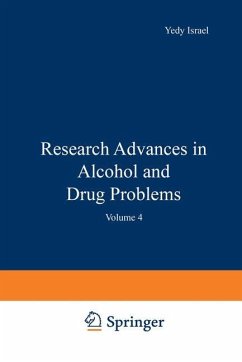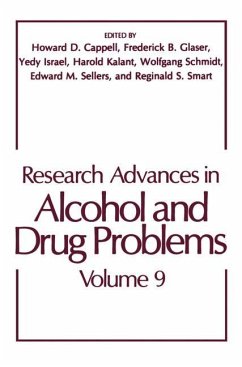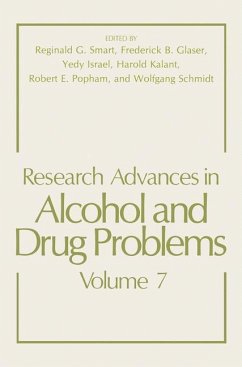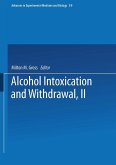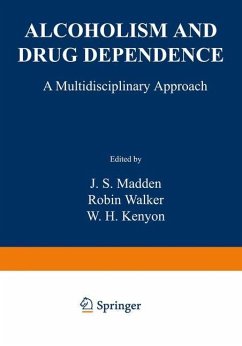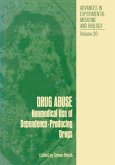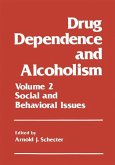Research Advances in Alcohol and Drug Problems
Volume 4
Herausgegeben:Israel, Yedi
Research Advances in Alcohol and Drug Problems
Volume 4
Herausgegeben:Israel, Yedi
- Broschiertes Buch
- Merkliste
- Auf die Merkliste
- Bewerten Bewerten
- Teilen
- Produkt teilen
- Produkterinnerung
- Produkterinnerung
Over the last decade the world has experienced a growing interest in problems associated with the nonmedical use of drugs. This interest has corresponded to areal growth in the extent, diversity, and social impact of the use of alcohol and drugs in many societies. As a result, the amount of research and writing on the subject of drug problems has greatly increased, and it has become very difficult for one individual to keep up with all the relevant literature. There is thus an acute need in the field for critical reviews that assess current developments, and the present series is intended to…mehr
Andere Kunden interessierten sich auch für
![Research Advances in Alcohol and Drug Problems Research Advances in Alcohol and Drug Problems]() Research Advances in Alcohol and Drug Problems42,99 €
Research Advances in Alcohol and Drug Problems42,99 €![Research Advances in Alcohol and Drug Problems Research Advances in Alcohol and Drug Problems]() Research Advances in Alcohol and Drug Problems42,99 €
Research Advances in Alcohol and Drug Problems42,99 €![Alcohol Intoxication and Withdrawal Alcohol Intoxication and Withdrawal]() Alcohol Intoxication and Withdrawal42,99 €
Alcohol Intoxication and Withdrawal42,99 €![Alcoholism and Drug Dependence Alcoholism and Drug Dependence]() Alcoholism and Drug Dependence42,99 €
Alcoholism and Drug Dependence42,99 €![Drug Abuse Drug Abuse]() Drug Abuse42,99 €
Drug Abuse42,99 €![Alcohol Intoxication and Withdrawal I Alcohol Intoxication and Withdrawal I]() Milton M. GrossAlcohol Intoxication and Withdrawal I42,99 €
Milton M. GrossAlcohol Intoxication and Withdrawal I42,99 €![Drug Dependence and Alcoholism Drug Dependence and Alcoholism]() Drug Dependence and Alcoholism83,99 €
Drug Dependence and Alcoholism83,99 €-
-
-
Over the last decade the world has experienced a growing interest in problems associated with the nonmedical use of drugs. This interest has corresponded to areal growth in the extent, diversity, and social impact of the use of alcohol and drugs in many societies. As a result, the amount of research and writing on the subject of drug problems has greatly increased, and it has become very difficult for one individual to keep up with all the relevant literature. There is thus an acute need in the field for critical reviews that assess current developments, and the present series is intended to fill this need. The series is not to be an "annual review" in the usual sense. The aim is not to cover all the work reported during the preceding year in relation to a fixed selection of topics. Rather , it is to present each year evaluative papers on topics in which enough recent progress has been made to alter the general scope in a particular area. Owing to the multidisciplinary nature of problems of drug use and dependence, the papers published in each volume will be drawn from several disciplines. However, some volumes may be devoted to one partic ular problem, with individual reviews and papers examining various aspects of it. The composition of the editorial board and the international advisory board reflects these objectives. The editors are members of the senior scientific staff of the Addiction Research Foundation of Ontario.
Hinweis: Dieser Artikel kann nur an eine deutsche Lieferadresse ausgeliefert werden.
Hinweis: Dieser Artikel kann nur an eine deutsche Lieferadresse ausgeliefert werden.
Produktdetails
- Produktdetails
- Verlag: Springer / Springer US / Springer, Berlin
- Artikelnr. des Verlages: 978-1-4615-7736-2
- Softcover reprint of the original 1st ed. 1978
- Seitenzahl: 516
- Erscheinungstermin: 12. Oktober 2012
- Englisch
- Abmessung: 229mm x 152mm x 28mm
- Gewicht: 737g
- ISBN-13: 9781461577362
- ISBN-10: 1461577365
- Artikelnr.: 38034104
- Herstellerkennzeichnung
- Books on Demand GmbH
- In de Tarpen 42
- 22848 Norderstedt
- info@bod.de
- 040 53433511
- Verlag: Springer / Springer US / Springer, Berlin
- Artikelnr. des Verlages: 978-1-4615-7736-2
- Softcover reprint of the original 1st ed. 1978
- Seitenzahl: 516
- Erscheinungstermin: 12. Oktober 2012
- Englisch
- Abmessung: 229mm x 152mm x 28mm
- Gewicht: 737g
- ISBN-13: 9781461577362
- ISBN-10: 1461577365
- Artikelnr.: 38034104
- Herstellerkennzeichnung
- Books on Demand GmbH
- In de Tarpen 42
- 22848 Norderstedt
- info@bod.de
- 040 53433511
1. Biological Significance of the Endogenous Opioid Peptides and the Opiate Receptors.- 1. Introduction.- 2. Structures of Enkephalins and Endorphins.- 3. Distribution of the Short-Chain Peptides (Enkephalins) and Long-Chain Peptides (Endorphins).- 4. Synthesis and Metabolism of the Opioid Peptides.- 5. Release of Enkephalins.- 6. Interaction of the Opioid Peptides with Opiate Receptors.- 7. Physiological Significance of the Opioid Peptides.- 8. The Role of Opioid Peptides in Tolerance and Dependence.- References.- 2. Brain Reinforcement Centers and Psychoactive Drugs.- 1. Behavioral Significance of Reward.- 2. Discovery of Electrical Self-Stimulation.- 3. Interpretation of Electrical Self-Stimulation.- 4. Early Anatomical Studies.- 5. Chemical Specificity and the Role of Monoamines.- 6. Monoamine Neurones and Electrical Self-Stimulation.- 7. Afferents to Reward Mechanisms.- 8. Effects on Self-Stimulation Behavior of Drugs Reducing Catecholaminergic Transmission.- 9. Effects of Drugs Enhancing Catecholamine Transmission on Self-Stimulation Behavior.- 10. Drugs Affecting Serotonergic Transmission.- 11. Drugs Affecting Cholinergic Transmission.- 12. Other Psychotropic Drugs.- 13. Summary and Conclusions.- References.- 3. Animal Studies of Alcohol Withdrawal Reactions.- 1. Introduction: The Human Alcohol Withdrawal Syndrome.- 2. Alcohol Administration and Descriptions of Withdrawal Reactions in Various Species.- 3. Factors That Affect the Severity of Withdrawal Reactions.- 4. Nature of the Dependent State.- References.- 4. Acetaldehyde-Its Metabolism and Role in the Actions of Alcohol.- 1. Introduction.- 2. Physicochemical and Biochemical Properties of Acetaldehyde.- 3. Determination of Acetaldehyde from Biological Samples.- 4. Sources of Acetaldehyde and Its Formationfrom Ethanol in the Body.- 5. Elimination of Acetaldehyde.- 6. Metabolic Consequences of Acetaldehyde Oxidation in the Liver.- 7. Blood Acetaldehyde.- 8. Occurrence of Acetaldehyde in the Brain.- 9. Antabuse and Related Compounds.- 10. Acetaldehyde and Voluntary Alcohol Consumption.- 11. Acute Pharmacological Effects of Acetaldehyde.- 12. Alcohol Abuse, Organ Pathology, and Acetaldehyde.- 13. Acetaldehyde and Mechanisms of Alcohol Dependence.- 14. Summary.- References.- 5. Patient Characteristics as Predictors of Treatment Outcomes for Alcohol and Drug Abusers.- 1. Introduction.- 2. Characteristics of Alcoholic Patients in Relation to Treatment Outcome.- 3. Limitations of Bivariate Analyses.- 4. Multivariate Analyses.- 5. Studies Involving Two or More Treatments.- 6. Characteristics of Alcoholic Patients Dropping Out of Treatment.- 7. Alcoholic Patient Characteristics and Other Aspects of Treatment.- 8. Conclusions from the Alcoholism Literature.- 9. Characteristics of Drug-Dependent Patients as Predictors of Treatment Outcomes.- 10. Conclusions from the Drug Dependence Literature.- 11. Epilogue.- References.- 6. The Social History of the Tavern.- 1. Introduction.- 2. The Primitive Background.- 3. The Origin of the Tavern.- 4. The Taverns of Babylonia and Assyria.- 5. The Taverns of Ancient Egypt.- 6. The Taverns of Ancient Arabia and Palestine.- 7. The Taverns of Classical Greece.- 8. The Taverns of Classical Rome.- 9. Urbanism and the Tavern in Ancient Civilizations.- 10. The Taverns of Medieval England.- 11. English Taverns from the Sixteenth to the Eighteenth Century.- 12. The Tavern in Colonial America.- 13. The Saloon Period in the United States.- 14. Prohibition and the Emergence of the Modern Tavern.- 15. Addendum: The Tavern and Social Change.- References.- 7.Level of Consumption and Social Consequences of Drinking.- 1. Introduction.- 2. Drinking and Consequences on the Individual Level.- 3. Level of Drinking and Consequences in Aggregates.- 4. Conclusions.- References.- 8. Alcohol Use among North American Blacks.- 1. Introduction.- 2. Drinking Practices and Behavior.- 3. Health and Physiological Effects.- 4. Crime and Alcohol-Related Offenses.- 5. Treatment.- 6. Summary and Discussion.- 7. Conclusions and Recommendations for Future Research.- References.- 9. The Etiologic Relationship between Drug use And Criminality.- 1. Introduction.- 2. Direct Pharmacological Effects.- 3. Indirect Effects: Studies Primarily Restricted to Nonnarcotic Drugs.- 4. Studies Emphasizing Narcotic Drug Use.- 5. Conclusions.- References.- 10. Decriminalization of Public Drunkenness.- 1. Introduction.- 2. The Problem.- 3. Degrees of Decriminalization.- 4. Functions of the Criminal Justice Approach.- 5. Police Reactions.- 6. Use of the Criminal Law Alternative.- 7. Detoxication.- 8. Other Consequences of Decriminalization.- 9. Conclusions.- References.- 11. The Treatment of Cigarette Dependence.- 1. Introduction.- 2. Smoking Withdrawal Clinics and Group Approaches.- 3. Drug Therapy.- 4. Hypnosis.- 5. Aversion Therapy.- 6. Self-Control Approaches.- 7. Miscellaneous Treatments.- 8. Comparative Trials.- 9. Alternatives to Treatment.- 10. Discussion.- 11. Summary.- References.
1. Biological Significance of the Endogenous Opioid Peptides and the Opiate Receptors.- 1. Introduction.- 2. Structures of Enkephalins and Endorphins.- 3. Distribution of the Short-Chain Peptides (Enkephalins) and Long-Chain Peptides (Endorphins).- 4. Synthesis and Metabolism of the Opioid Peptides.- 5. Release of Enkephalins.- 6. Interaction of the Opioid Peptides with Opiate Receptors.- 7. Physiological Significance of the Opioid Peptides.- 8. The Role of Opioid Peptides in Tolerance and Dependence.- References.- 2. Brain Reinforcement Centers and Psychoactive Drugs.- 1. Behavioral Significance of Reward.- 2. Discovery of Electrical Self-Stimulation.- 3. Interpretation of Electrical Self-Stimulation.- 4. Early Anatomical Studies.- 5. Chemical Specificity and the Role of Monoamines.- 6. Monoamine Neurones and Electrical Self-Stimulation.- 7. Afferents to Reward Mechanisms.- 8. Effects on Self-Stimulation Behavior of Drugs Reducing Catecholaminergic Transmission.- 9. Effects of Drugs Enhancing Catecholamine Transmission on Self-Stimulation Behavior.- 10. Drugs Affecting Serotonergic Transmission.- 11. Drugs Affecting Cholinergic Transmission.- 12. Other Psychotropic Drugs.- 13. Summary and Conclusions.- References.- 3. Animal Studies of Alcohol Withdrawal Reactions.- 1. Introduction: The Human Alcohol Withdrawal Syndrome.- 2. Alcohol Administration and Descriptions of Withdrawal Reactions in Various Species.- 3. Factors That Affect the Severity of Withdrawal Reactions.- 4. Nature of the Dependent State.- References.- 4. Acetaldehyde-Its Metabolism and Role in the Actions of Alcohol.- 1. Introduction.- 2. Physicochemical and Biochemical Properties of Acetaldehyde.- 3. Determination of Acetaldehyde from Biological Samples.- 4. Sources of Acetaldehyde and Its Formationfrom Ethanol in the Body.- 5. Elimination of Acetaldehyde.- 6. Metabolic Consequences of Acetaldehyde Oxidation in the Liver.- 7. Blood Acetaldehyde.- 8. Occurrence of Acetaldehyde in the Brain.- 9. Antabuse and Related Compounds.- 10. Acetaldehyde and Voluntary Alcohol Consumption.- 11. Acute Pharmacological Effects of Acetaldehyde.- 12. Alcohol Abuse, Organ Pathology, and Acetaldehyde.- 13. Acetaldehyde and Mechanisms of Alcohol Dependence.- 14. Summary.- References.- 5. Patient Characteristics as Predictors of Treatment Outcomes for Alcohol and Drug Abusers.- 1. Introduction.- 2. Characteristics of Alcoholic Patients in Relation to Treatment Outcome.- 3. Limitations of Bivariate Analyses.- 4. Multivariate Analyses.- 5. Studies Involving Two or More Treatments.- 6. Characteristics of Alcoholic Patients Dropping Out of Treatment.- 7. Alcoholic Patient Characteristics and Other Aspects of Treatment.- 8. Conclusions from the Alcoholism Literature.- 9. Characteristics of Drug-Dependent Patients as Predictors of Treatment Outcomes.- 10. Conclusions from the Drug Dependence Literature.- 11. Epilogue.- References.- 6. The Social History of the Tavern.- 1. Introduction.- 2. The Primitive Background.- 3. The Origin of the Tavern.- 4. The Taverns of Babylonia and Assyria.- 5. The Taverns of Ancient Egypt.- 6. The Taverns of Ancient Arabia and Palestine.- 7. The Taverns of Classical Greece.- 8. The Taverns of Classical Rome.- 9. Urbanism and the Tavern in Ancient Civilizations.- 10. The Taverns of Medieval England.- 11. English Taverns from the Sixteenth to the Eighteenth Century.- 12. The Tavern in Colonial America.- 13. The Saloon Period in the United States.- 14. Prohibition and the Emergence of the Modern Tavern.- 15. Addendum: The Tavern and Social Change.- References.- 7.Level of Consumption and Social Consequences of Drinking.- 1. Introduction.- 2. Drinking and Consequences on the Individual Level.- 3. Level of Drinking and Consequences in Aggregates.- 4. Conclusions.- References.- 8. Alcohol Use among North American Blacks.- 1. Introduction.- 2. Drinking Practices and Behavior.- 3. Health and Physiological Effects.- 4. Crime and Alcohol-Related Offenses.- 5. Treatment.- 6. Summary and Discussion.- 7. Conclusions and Recommendations for Future Research.- References.- 9. The Etiologic Relationship between Drug use And Criminality.- 1. Introduction.- 2. Direct Pharmacological Effects.- 3. Indirect Effects: Studies Primarily Restricted to Nonnarcotic Drugs.- 4. Studies Emphasizing Narcotic Drug Use.- 5. Conclusions.- References.- 10. Decriminalization of Public Drunkenness.- 1. Introduction.- 2. The Problem.- 3. Degrees of Decriminalization.- 4. Functions of the Criminal Justice Approach.- 5. Police Reactions.- 6. Use of the Criminal Law Alternative.- 7. Detoxication.- 8. Other Consequences of Decriminalization.- 9. Conclusions.- References.- 11. The Treatment of Cigarette Dependence.- 1. Introduction.- 2. Smoking Withdrawal Clinics and Group Approaches.- 3. Drug Therapy.- 4. Hypnosis.- 5. Aversion Therapy.- 6. Self-Control Approaches.- 7. Miscellaneous Treatments.- 8. Comparative Trials.- 9. Alternatives to Treatment.- 10. Discussion.- 11. Summary.- References.

